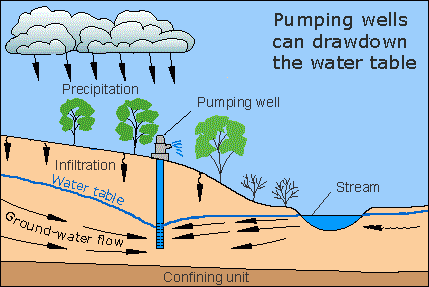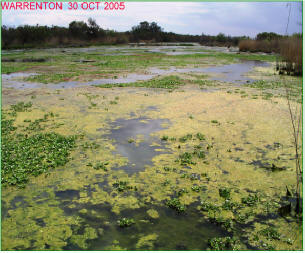Some
factors of ecological concern: E-coli,
Phosphorus, Nitrogen, anti-biotics, hormones,
..................
We
will examine one of these: Phosphorus
"Never doubt that a small group of
thoughtful , committed people can change the world.
- Margaret Mead"
Simple
formula to determine setback distance. = If a
water system is green with toxic algae, it is
obvious whatever setback limits or
anti-pollution steps were taken, they were
inadequate. Conclusion...
.Correct situation pronto.
What is the importance
of Phosphorus in water pollution, as an
indicator and as a contributor .
| The
fecal component of manure if buried as in a
septic system if a proper disposal bed
destroys that component before it exits the
system. a setback of 100 ft -400 ft seams to
purify the fecal component of the waste*1 Surface waste
piles may respond differently.
Chemicals
& fertilizers containing phosphate
can cause algae blooms in the absence of
coliform therefore phosphate levels are also a
valuable indicator of environmental health.
|
*1
http://www.sdw-eps.gc.ca/rprt/vlm2/wlls_e.asp
Wells must be at least 100 feet
from any probable source of contamination, such
as a privy vault, cesspool, manure heap, stable
or pigsty, and at least 20 feet from any
dwelling house, and at least 400 feet from any
cemetery or dumping ground (subject to
exceptions)
http://www.rappmonitor.va.nacdnet.org/intro.htm
* Measures of fecal coliform
are used to indicate possible sewage
contamination as fecal coliforms are found in
animal and human feces. * Fecal coliform
bacteria are not harmful themselves, but they
indicate the possible presence of disease
causing bacteria, viruses and protozoan that
live in digestive tracts. * They can also
cause unpleasant odors, cloudy water and
increase oxygen demand. |
1. Element or material causing problem
Their are many minerals that can cause problems in
aquatic systems. The most important is the one that is
in the least supply, this is referred to as the limiting
factor. Since blue-green algae are nitrogen
fixing organisms, phosphorus is their limiting
factor, and it is an element that they need for
growth.
| 2. Type of waste compost.
Cattle, Pigs, Chicken, Mink.....Diet of live
stock determines the type of waste and there
are difference in the same species in
different locations. .
Phosphorus is a principal element that
results in algae growth. It is a
limiting factor that once added to the system
can result in algae growth 500*1 times
it's own weight.
Manure Nutrient Content*2 for
Various Livestock Species
Pounds per ton of
phosphorus. *Based on averages form
a variety of sources. Actual farm values
may vary greatly.

Mp=
Factor related to amount P in manure
Let's say Range 0 to 10 with mink at range of
5 cows at 0.4
Therefore the distance removed from water
source depends to some extent on the type of
manure.
|
*1source
http://www.serc.com/phosphorus/fact.html
Phosphorus is the nutrient that
“limits” (is most essential to) aquatic plant
growth. This means that, if aquatic plants,
such as algae, have excess phosphorus to
adsorb, they can grow out of control.
* One pound of phosphorus
can result in the growth 350-700 lbs. of
green algae.
* Algal blooms and excessive
submerged aquatic vegetation (SAV) growth can
lead to the biological death, or
eutrophication, of a body of fresh water.
* Blooms of blue-green algae
produce neurotoxins (affecting the nervous
system) and hepatoxins (affecting the liver),
and can cause a serious public health problem
as well as damage aquatic habitats.
* On the economic side,
excessive SAV and algal growth due to
phosphorus pollution increases water treatment
costs, degrades fishing and boating
activities, and impacts tourism and property
values.(1)
* Phosphorus pollution needs to
be remediated 70-90% before a lake can recover
from eutrophication.(2)
*2 http://gis.lrs.uoguelph.ca/AgriEnvArchives/bioenergy/facts.html#Composition
Phosphorus is expressed as
phosphate equivalent in lbs/ton (kg/tonne) |
3. Amount of waste compost. (X Bomb)
If a meteorite hits the earth, the point
source, or impact point is more or less the
centre of the creator left
behind. When an pollution hits the
earth a similar crater is created.
A meteor leaves a physical hole while an X
Bomb creates and *ecological hole(EH) not just a
foot print but rather an **ecological stomp.
The magnitude on the impact is a factor
related to the amount of waste, type of waste,
accumulation over time.
The effect of the stomp is determined by of
the ability of the ecosystem to absorb the
impact, which in turn is dependent on a
multitude of factors of which setback distance
is one.
The ability of "Spaceship Earth" to repair
this ecological hole
is determined by of the ability of that
ecosystem to process the impact (ecological
resistance ER), which in
turn is dependent on a multitude of factors
including human intervention . Some areas have
a high
The ER of an aquatic
system to phosphorus impact is low, that is
the system has a difficult time to safely
incorporate it,
while grassy meadows ability to utilize the
mineral in a safe way is relatively high.
Hypothetical scale for an ecosystem to absorb
phosphorus (ecological resistance or ability
to utilize phosphates ERP)

The following formula
( EH =
(MP x MX)/ERP
)
can be used to compare the effect manure on an
ecosystem . We see (calculations in right
column) that aquatic systems are much more
sensitive to pollution from mink manure than cow
manure, at least with respect to phosphorus
levels. The pollution units (Pu) of 500 for mink
and 40 for cow
We also see that mink manure is a much more
valuable a commodity as a
fertilizer. Providing more
phosphorus than cow manure.
Terms
* Ecological Hole:
When a section of the biosphere is no longer
able to live up to it's ecological
potential.
**Ecological Stomp:
Footprint is a measure of demand we place on
the biosphere while stomp represents a
serious blow to it's survival.
X Bomb = The
collision of substance X (chemical,
biological etc.) with an
ecosystem. P Bomb =
Phosphors S=Manure X=whatever and
so on. |
Causes of Non-Point Source Water
Pollution in BC
http://www.env.gov.bc.ca/wat/wq/bmps/npsaction.html#causes
The more contaminants in water,
the greater the risk to humans, fish, and
animals. Even small amounts of contaminants in
small amounts of runoff result in cumulative
effects over an entire watershed and, building
up over time, can have a significant impact.
Locating the sources of pollution and removing
contaminants before they reach the water
provides the best assurance of clean water
in the future.
There are no ecosystems just one
biosphere
Canadian
Water Advisory Map - 9/5/09
Boil Water Advisories
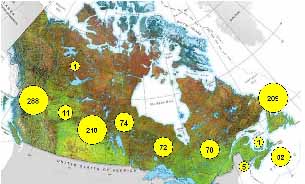
http://www.water.ca/wkd-91209.asp
Water can process the impact of a meteorite much
more easily then a hit from an Poo Bomb.
| Hypothetical formula
EH
= (MP x MX)/ERP
The following are some possible
comparisons.
Mink Manure in grassland
ecosystem
EH =
(50lb/ton x 20tons) /8 =
125
Mink Manure in Aquatic ecosystem
EH =
(50lb/ton x 20tons) /2 =
500
Cow Manure in grassland
ecosystem
EH =
(4lb/ton x 20tons) /8 = 10
Cow Manure in aquatic
ecosystem
EH =
(4lb/ton x 20tons) /2 = 40
|
Must visit site for
information
on Canadian Pollution Policies

Environment Canada Site Map
"Sometimes nature itself can produce these
imbalances.
Often our waterways are being polluted by
municipal, agricultural and industrial wastes,
including many toxic synthetic chemicals which
cannot be broken down at all by natural
processes. Even in tiny amounts, some of these
substances can cause serious harm."
|
| Setback distance
Area for absorption on compost nutrients into
soil
It is obvious that the greater the setback
distance the less likely material will enter
water systems. What may not be as
obvious is that a doubling of distance results
in a quadrupling of area from the centre to
the perimeter. We are not just dealing
with surface are but depth of soil. See
calculations to the right. Go to link
for making more calculations.
| Conclusion: The
greater the setback distance the
greater the ability of the substrate
to absorb nutrients.
However the storage area is finite
and eventually even under ideal
conditions the limits will exceed
the holding capacity and leaching
into aquatic ecosystem will occur. |
In the real world runoff, streams and
subterranean water movement will greatly effect
the rate at which nutrients are transferred to
aquatic systems. So ultimately we are
faced with determining how much nutrients a
system can process before these nutrients become
pollutants.
Ecosystems need nutrients and can process
within limits, but there comes a point
(Tipping Point ) where we get to much of a
good thing and the effects can be far reaching
and long lived.
***Very
Important Document***
WATER QUALITY
SURVEY OF NINE LAKES
(Copy
Pdf Format)
|
Area in relations to setback distance (area of circle)
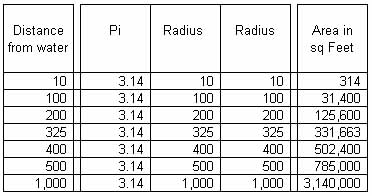
Answer: 1 acre = 0.404685 hec
Answer: 1 hec = 2.47105 acre http://www.metric-conversions.org/area/acres-to-hectares.htm
volume = (Pi * h2 * r) - (Pi * h3 /
3) (source + calculator)
If we assume that the soil depth is30 feet
Volume of 100 foot circle
= 254,469 cubic
feet
Volume of 325 foot circle
= 890,641 cubic
feet
Volume of 500 foot circle
= 1,385,442 cubic feet
Volume of 5000 foot circle =
14,108,892 cubic feet
***Very
Important
Document***
A WATER QUALITY SURVEY OF NINE LAKES IN
THE CARLETON RIVER WATERSHED AREA YARMOUTH
COUNTY, NOVA SCOTIA
The Carleton River is in
the Southern Upland region of the
province, draining
approximately 200 km 2 of
watershed, and contains nearly 100 lakes.
Prepared by Water & Wastewater Branch
Nova Scotia Environment Darrell Taylor
Project Lead March 18, 2009 (Copy
Pdf Format) |
Personal
Rant................
In the course of
discussion over the past few months the
impression was given that it would be very
difficult to solve the algae problem in the
Carleton because the point source could not
be located. Using this as a reason for
inaction or misdirected action, the
scientific stupidity of this statement, is
one of the things that has irked
me. A Point Source is something
like the 18 inch sewage pipe that Mr. Randy
Cleveland refereed to that was in the mink
ranch area. It is a source that you can
visibly see, which I presume has been
cleaned up by now. The source of this
pollution is not an enigma. More
scientifically knowledgeable individuals
will not resort to this confusing
point/non-source point deception.
Another definition -
Point Source: A source, especially of
pollution or radiation, occupying a very
small area and having a concentrated
output. In order to detect point
source radiation, that you cannot
see, you need instruments. The
same is used to pin point the source of a
so called non-point source
pollutant. There are situations
where locating the source of pollution is
difficult, but this is not one of
them.
|
| How much land do we need to safely
dispose of a specific amount of
manure?
The following estimations can be calculated
using the amount of manure produced,
which is a bit complicated to determine or on
the amount of mink producing manure. I
will chose the latter.
Source of stats in column at right.
Weight of Manure = (#of Mink
x waste/mink/year) /2000
Wm = (M# x 44)/2000
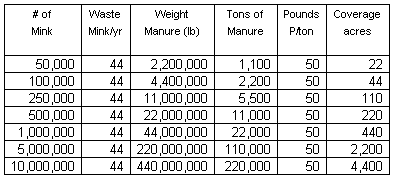
| Conclusion: You
cannot safely store the waste of
1,000,000 animals on a few acres of
land when the waste out-put
represents an amount that is
suitable for spreading over 100's.
of acres/yr. |
This especially cannot be done year after
year or you will get what you got.....
an ecological disaster.
|
Land plants are more
sensitive to Nitrogen excess than
Phosphorus. The amount added to the soil
also depends on the amount that is already
there.
We cannot add more minerals to the soil than it
can use otherwise it will end up in water
systems. Nutrient Removal per ton of hay Nitrogen
40 lb N, Potassium
60 lb K 2O, Phosphate 13
lb P 2O5 (Source)
About 44 pounds of feces are excreted per
mink skinned by fur farmers. Based on the
total number of minks skinned in the U.S. in
1999, which was 2.81 million, mink factory farms
generate approximately 62,000 tons of manure per
year. One result is nearly 1,000 tons of
phosphorus, which wreaks havoc in water
ecosystems. (Source)
Mink manure contains about 50 lb
phosphorus in 2000 lb,1 ton of manure (source
)
Mink
manure is part of the problem!
Mink
ranchers have to be part of the
solution.
Mink
stink but most of
the
farmers smell OK.
|
(Return to Home Page)
| How can one determine the amount of
minerals dissolved in soil at
various depths.
If it were necessary to do this one method is
to drill or push hollow rod into soil.
to be continued...........
|
Drill hole or insert hollow tube into soil that is
able to take sub soil samples
About 44 pounds of feces are excreted per mink skinned
by fur farmers. Based on the total number of minks
skinned in the U.S. in 1999, which was 2.81 million,
mink factory farms generate approximately 62,000 tons
of manure per year. One result is nearly 1,000 tons of
phosphorus, which wreaks havoc in water ecosystems.
UNDER CONSTRUCTION
Stop here
Plant eaters excrete a different type of waste than
meat eaters. Birds are not mammals and the
waste they produce is radically different in it's
composition and eventual environmental impact.
4. Rate of biological conversion of waste to plant
material.
5. What effects does it have on the quality of life of
the community it is in.
Topic Settling ponds vs semi isolated
spring fed ponds vs moving water vs salt water vs
contained and controlled dispersal
6. Spring fed lack as a settling pond.
Settling ponds are often constructed to retard the
migration on environmental pollutants but what happens
when a natural water way becomes a settling pond.
12 Manure is a valuable source of nutrients for
plants growth and to simply bury it is a waste of
resources.
Theoretically the manure should be to valuable to have
leach away.
13. Quantitative analysis vs Quantitative comparison
14 Manure as a catalyst to carbon capture and
greenhouse gas reduction.
What next?
disclosure of construction before
construction begins
Should not allow the construction of more farms until
it has been demonstrated that the operations can
function with minimal environmental impact, and with
respect to air and water quality.
|
